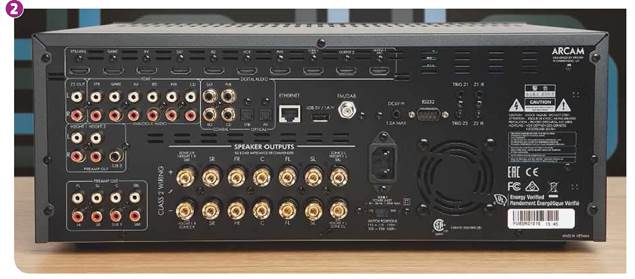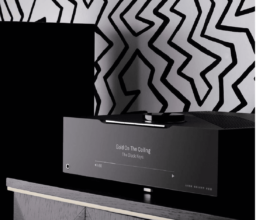Arcam AVR850 review
Contents
Av info
PRODUCT: Seven-channel AVR with Dirac calibration
Position: Arcam’s previous flagship receiver, now being replaced by the AVR30
Peers: NAD T777 V3; Anthem MRX 720
TIME ON TEST: 18 months
REVIEWER: Steve Withers
Arcam has recently announced a new lineup of AV receivers as part of its HDA range, adding an updated design, extended immersive audio processing, eARC and built-in Wi-Fi. However, the differences don’t appear to be huge, making this the perfect time to consider buying an AVR850 as dealers cut prices to clear inventory.
What’s good about it?
The AVR850 remains an impressive AV receiver, capable of decoding and processing Dolby Atmos and DTS:X object-based audio for up to 12 channels. There’s no Auro-3D playback, but that’s hardly a great loss, and Arcam recently added IMAX Enhanced support. The newer HDA receivers can process up to 16 channels, but 7.1.4 is probably more than enough for most people.
Class G amplification (which again features on Arcam’s HDA models) is a hybrid technology that aims to combine the efficiency of Class A/B with the transparent, audiophile quality of Class A. Arcam describes it as operating much like a turbo-charged car engine, only utilising its power supplies at full output when required. The AVR850 is not only responsive and powerful, but able to drive its seven channels simultaneously to a claimed 100W into 8 ohms.
Arcam was an early adopter of Dirac Live, and this sophisticated room equalisation remains the best option for higher-end processors and receivers. It uses a calibrated microphone combined with a well-designed interface to produce a graphical representation of the system’s in-room measurements, and then applies custom filters to the frequency and impulse responses.
Calibrated and fed a Blu-ray soundmix, the AVR850 delivers a stunning sonic performance, with superb processing that steers effects with panache and squeezes every last detail out of your source. Thanks to Dirac Live, negative environmental acoustics are tackled, leaving a tonally balanced and cohesive soundstage that will take your breath away.
The powerful amplification generates remarkable transients, and there’s head room to spare. Add four more channels and the resulting 7.1.4 system can render some of the best object-based action you’re likely to hear from any AV receiver.
Spending a prolonged period of time with the AVR850 has also provided the chance to evaluate the long-term reliability of its software platform. Owners of the AVR600 know too well that earlier models were prone to reliability issues, but that certainly isn’t the case with this receiver.
It hasn’t put a foot – or indeed a circuit board – wrong in all the time I’ve been using it.
What’s not so good about it?
The entire FMJ range looks dated, especially the green dot matrix display and spartan, industrial design. But on the plus side, the AVR850 is built like a tank and the black matte finish doesn’t draw attention to itself. The new HDA range has undergone a makeover, with at least the display looking like an improvement.
The obvious issue when it comes to the AVR850 is that it only has seven channels of built-in amplification, which means those wanting to run a full 7.1.4 immersive audio setup need to add four more channels (which could end up costing quite a lot). To be fair, the new HDA models have the same limitation, and restricting the channels allows Arcam to make the onboard amplification genuinely powerful.
What is more annoying is the inability to reassign the built-in amplification to different channels (beyond the 6th and 7th channels being tasked to Zone 2 or L/R bi-amping). This means you can’t use an external power amp for the front left and right channels, and then allocate the spare amplification to drive a pair of overhead speakers. As a result you’re largely restricted to using any additional outboard amplification for your four height speakers.
The HDMI connections are plentiful, with seven inputs and three outputs, but – unsurprisingly given they date back four years – these ports are restricted to version 2.0a. That means no support for eARC (Enhanced Audio Return Channel) or HDR10+, although Arcam recently added Dolby Vision passthrough via a firmware update.
The AVR850 also lacks any wireless support, which means no Wi-Fi, Bluetooth or Apple AirPlay. As a result, users are forced to connect an Ethernet cable if they want to access their network or run Dirac Live. It’s a first-world problem, but still a nuisance. The new receivers include built-in Wi-Fi, Bluetooth, and AirPlay 2, all of which are welcome additions.
Finally there’s the universal remote control, which isn’t badly designed per se, but includes a frustrating quirk. When you press one of the input buttons, Blu-ray for example, the remote no longer controls the AVR850.
You need to remember to press the ‘Amp’ button to regain full control of the receiver. It’s a small thing, but it annoys me every time.
Should I buy it?
The AVR850 remains as great now as it did when it launched four years ago, and thanks to an upgradable platform, Arcam has been able to add new features through firmware updates. The result is an AV receiver that’s still a force to be reckoned with, and anything that’s missing is hardly essential. In the end, class never goes out of style, but sometimes it gets cheaper and now might be the ideal opportunity to pick up a bargain
VERDICT

2. … but you’ll find eight of them (plus three outputs) around the back
SPECIFICATIONS
DOLBY ATMOS: Yes DTS:X: Yes IMAX ENHANCED: Yes MULTICHANNEL INPUT: Yes. 7.1 phono MULTICHANNEL PRE-OUT: Yes. 11.2 phono MULTICHANNEL OUTPUT (CLAIMED):
7 x 100W (into 8 ohms) MULTIROOM: Yes. Second AV zone AV INPUTS: 6 x digital audio inputs (4 x coaxial, 2 x optical) HDMI: Yes. 7 x inputs; 3 x outputs COMPONENT VIDEO: No VIDEO UPSCALING: No DIMENSIONS: 433(w) x 425(d) x 171(h)mm WEIGHT: 16.7kg
FEATURES: Dirac Live room EQ/setup; Ethernet; USB; 3.5mm input; 6 x stereo analogue audio inputs; networked media playback (including FlAC, MP3, WMA, WAV, AAC); DAB/Fm tuner; internet radio; Class G amplifier design; twin subwoofer outputs; MusicLife iOS UPnP/control app; RS-232; 2 x 12V triggers; 2 x IR inputs; learning remote control; HDMI 2.0a/HDCP 2.2








Nice assessment. Given the reduction in price and no need for WiFi or any of the new features in the HDA I bought the AVR850 and subsequently combined it with an Arcam P429. for a 5.1.2 set-up – this for the same cost as the AVR30. The reason for getting the P429 the power reserves which made it sound less stressed at loud levels. The two configurations I have tried are using the P429 in bridged mode to run the fronts, and bridge mode for the center with the heights on the other two outputs allowing bi-amping the fronts. I found the former set-up the better alternative.
The only real setbacks for me is the lack of extra “slots” for Dirac and the lack of future FW updates (at least I do not think there will be any meaning the last quirks will never be ironed out, e.g. crossover for heights defaults to 50Hz when turning on the system but mitigated in the Dirac room-correction target curve I assign to the hights).
As the AVR30 wasn’t available at the time I did not get around to audit it, but given the upgraded DAC I could imagine an extra tad in sonic quality. The rest of extra features I have no need for so for me not a trade-off. regarding the display I am not convinced – at least the FMJ can be read from a distance contrarily to the HDA. In fact the HDA design is not to my taste and wouldn’t get into the house.
The remote issue depends. If you use the remote to control your other equipment it is nice that it is changed to operate the CD player when you push the CD button.